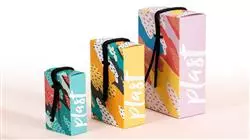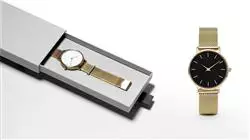University certificate
The world's largest faculty of design”
Introduction to the Program
Develop an advanced mastery of structures, materials and Ecopackaging, as well as visual communication to adapt them to a market strategy in this 100% online program. Enroll now”

The image of the products is really important in the market environment, the influence it generates in the quick distinction, the purchase decision, the safety and quality of the product. These are aspects to be treated with importance and care within the process and productive planning of the company.
The new Phygital reality also requires a more intense approach to Packaging Design that combines digital and virtual environments with Concept Stores and Retail, so vector illustration, the mastery of Big Data and the design of the end customer experience are also axes of this teaching.
The mastery of structures, materials and Ecopackaging, as well as visual communication to adapt them to a competitive market strategy based on analysis, together with the latest artistic techniques to promote creativity and its application, both to the premium and luxury sector and to the mass market, will provide students with the necessary skills for their incorporation into the multifaceted Packaging market in constant innovation and evolution.
This Masters Degree, delves into the use of the most advanced tools and implementation of illustration techniques, understanding the fundamental concepts of Packaging Design. It takes the concept of sustainability as the main axis in the design style and novel aspects such as artificial intelligence and digital innovation to improve the user experience.
A specialized syllabus, developed and rigorously selected by experts in visual arts, marketing and communication, based on an innovative teaching methodology 100% online that adapts to the personal circumstances of each student, since it allows you to choose the time and place to study. In this way, numerous multimedia teaching resources such as practical exercises, video techniques, interactive summaries or master classes are used to achieve the degree in 12 months.
You will master the principles of Packaging Design thanks to this Masters Degree, which will give you access to numerous professional opportunities"
This Masters Degree in Packaging Design contains the most complete and up-to-date educational program on the market. The most important features include
- The development of practical cases presented by experts in Design, Marketing and Communication
- The graphic, schematic, and practical contents with which they are created, provide scientific and practical information on the disciplines that are essential for professional practice
- Practical exercises where the self-assessment process can be used to improve learning
- Its special emphasis on innovative methodologies
- Theoretical lessons, questions to the expert, debate forums on controversial topics, and individual reflection assignments
- Content that is accessible from any fixed or portable device with an Internet connection
After this program, you will be able to work in the consumer, luxury and gourmet markets, designing innovative and functional packaging solutions for their products"
The program’s teaching staff includes professionals from sector who contribute their work experience to this program, as well as renowned specialists from leading societies and prestigious universities.
The multimedia content, developed with the latest educational technology, will provide the professional with situated and contextual learning, i.e., a simulated environment that will provide immersive education programmed to learn in real situations.
This program is designed around Problem-Based Learning, whereby the professional must try to resolve the different professional practice situations that arise during the academic year. For this purpose, students will be assisted by an innovative interactive video system developed by renowned experts.
Develop new creative concepts through innovative ideas and Adobe Illustrator tools in Product Packaging Design"

Enroll now and see your goal come true in 12 months in an agile, comfortable and efficient way.Thanks to the 100% online methodology based on Relearning"
Why study at TECH?
TECH is the world’s largest online university. With an impressive catalog of more than 14,000 university programs available in 11 languages, it is positioned as a leader in employability, with a 99% job placement rate. In addition, it relies on an enormous faculty of more than 6,000 professors of the highest international renown.

Study at the world's largest online university and guarantee your professional success. The future starts at TECH”
The world’s best online university according to FORBES
The prestigious Forbes magazine, specialized in business and finance, has highlighted TECH as “the world's best online university” This is what they have recently stated in an article in their digital edition in which they echo the success story of this institution, “thanks to the academic offer it provides, the selection of its teaching staff, and an innovative learning method aimed at educating the professionals of the future”
A revolutionary study method, a cutting-edge faculty and a practical focus: the key to TECH's success.
The most complete study plans on the university scene
TECH offers the most complete study plans on the university scene, with syllabuses that cover fundamental concepts and, at the same time, the main scientific advances in their specific scientific areas. In addition, these programs are continuously being updated to guarantee students the academic vanguard and the most in-demand professional skills. In this way, the university's qualifications provide its graduates with a significant advantage to propel their careers to success.
TECH offers the most comprehensive and intensive study plans on the current university scene.
A world-class teaching staff
TECH's teaching staff is made up of more than 6,000 professors with the highest international recognition. Professors, researchers and top executives of multinational companies, including Isaiah Covington, performance coach of the Boston Celtics; Magda Romanska, principal investigator at Harvard MetaLAB; Ignacio Wistumba, chairman of the department of translational molecular pathology at MD Anderson Cancer Center; and D.W. Pine, creative director of TIME magazine, among others.
Internationally renowned experts, specialized in different branches of Health, Technology, Communication and Business, form part of the TECH faculty.
A unique learning method
TECH is the first university to use Relearning in all its programs. It is the best online learning methodology, accredited with international teaching quality certifications, provided by prestigious educational agencies. In addition, this disruptive educational model is complemented with the “Case Method”, thereby setting up a unique online teaching strategy. Innovative teaching resources are also implemented, including detailed videos, infographics and interactive summaries.
TECH combines Relearning and the Case Method in all its university programs to guarantee excellent theoretical and practical learning, studying whenever and wherever you want.
The world's largest online university
TECH is the world’s largest online university. We are the largest educational institution, with the best and widest online educational catalog, one hundred percent online and covering the vast majority of areas of knowledge. We offer a large selection of our own degrees and accredited online undergraduate and postgraduate degrees. In total, more than 14,000 university degrees, in eleven different languages, make us the largest educational largest in the world.
TECH has the world's most extensive catalog of academic and official programs, available in more than 11 languages.
Google Premier Partner
The American technology giant has awarded TECH the Google Google Premier Partner badge. This award, which is only available to 3% of the world's companies, highlights the efficient, flexible and tailored experience that this university provides to students. The recognition as a Google Premier Partner not only accredits the maximum rigor, performance and investment in TECH's digital infrastructures, but also places this university as one of the world's leading technology companies.
Google has positioned TECH in the top 3% of the world's most important technology companies by awarding it its Google Premier Partner badge.
The official online university of the NBA
TECH is the official online university of the NBA. Thanks to our agreement with the biggest league in basketball, we offer our students exclusive university programs, as well as a wide variety of educational resources focused on the business of the league and other areas of the sports industry. Each program is made up of a uniquely designed syllabus and features exceptional guest hosts: professionals with a distinguished sports background who will offer their expertise on the most relevant topics.
TECH has been selected by the NBA, the world's top basketball league, as its official online university.
The top-rated university by its students
Students have positioned TECH as the world's top-rated university on the main review websites, with a highest rating of 4.9 out of 5, obtained from more than 1,000 reviews. These results consolidate TECH as the benchmark university institution at an international level, reflecting the excellence and positive impact of its educational model.” reflecting the excellence and positive impact of its educational model.”
TECH is the world’s top-rated university by its students.
Leaders in employability
TECH has managed to become the leading university in employability. 99% of its students obtain jobs in the academic field they have studied, within one year of completing any of the university's programs. A similar number achieve immediate career enhancement. All this thanks to a study methodology that bases its effectiveness on the acquisition of practical skills, which are absolutely necessary for professional development.
99% of TECH graduates find a job within a year of completing their studies.
Master's Degree in Packaging Design
Packaging design or packaging design refers to the process of creating the design and exterior appearance of a box, bag, container or wrapper that is used to contain, protect and present products. The main objective of packaging design is to attract the consumer's attention, communicate the product's brand and message, and protect the product during transportation and storage. Packaging design is an important aspect of the marketing and production process of any product and good packaging design can differentiate the product from the competition and attract consumer attention.
Packaging design is a multifaceted process that involves creativity, marketing strategy, materials knowledge and production capability. Packaging designers work collaboratively with manufacturers, brand owners and marketing teams to create innovative and appealing packaging that meets brand, consumer and production constraints.
Packaging design can include elements such as shape, size, color, text, images and graphics. In addition, designers must consider the environment and ensure that packaging is sustainable and earth-friendly.
Our academic program in packaging design focuses on providing advanced training in the design and production of innovative and effective product packaging. This program is designed to develop advanced skills and knowledge in graphic design, marketing and production for packaging design. The objective of this Master's Degree program is to provide students with advanced training in the design, production and marketing of innovative and effective packaging for products. Upon completion of this program, students will gain skills necessary to create effective graphic designs, produce sustainable and environmentally friendly packaging, and communicate effectively with consumers. This will make them more competitive in the packaging design industry and enable them to create innovative and effective packaging solutions for products of all types.







